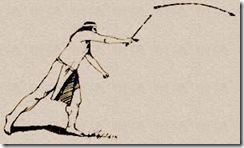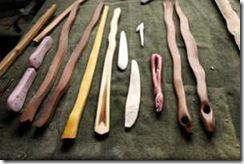To Atlatl Bob, what makes humans different from other creatures is the ability to throw things. To his friend, travel writer Tim Cahill, it’s the ability to tell stories.
Both are right. Here’s why.
Throwing Means Living to Eat Another Day
 The atlatl is a stick that you use to throw an arrow-like dart with great force to slay beasts or enemies from afar. Atlatl Bob (whose real name is Bob Perkins) decided to make one as a project for an anthropology course he took while pursuing a degree in engineering at Montana State University.
The atlatl is a stick that you use to throw an arrow-like dart with great force to slay beasts or enemies from afar. Atlatl Bob (whose real name is Bob Perkins) decided to make one as a project for an anthropology course he took while pursuing a degree in engineering at Montana State University.With fellow MSU student, Paul Leininger, Perkins formed “BPS Engineering” (the “Bob & Paul Show”), and started manufacturing atlatls. They blew away atlatl aficionados when they showed off their modern-day version of this pre-historic weapon at The Fifth Annual World’s Open Atlatl Contest at Saratoga, Wyoming, in 1985. Today BPS can sell you either an
 “Authentic Replica Atlatl” or a production model “Warrior Atlatl.”
“Authentic Replica Atlatl” or a production model “Warrior Atlatl.”Studying and building atlatls convinced Perkins that Neanderthals couldn’t have used it. First, after noting that Neanderthal remains sometimes contained broken bones, he realized that our Not-So-Distant hominid relatives must have had to belly up close to their movable feasts in order to kill them on the hoof and, by doing so, risked getting stomped into a bag of skin and busted limbs and ribs. (There is some evidence that Neanderthals occasionally stalked less dangerous dinner fixings: Veggies). Secondly, he discovered the reason that Neanderthals could not have stood at a safe distance from a wooly mammoth and dispatched it with a well-placed atlatl chuck, was that they lacked the type of “throwing shoulder” that lets a Major League pitcher bonk batters on the noggin with a flaming fastball.
Bob reasoned that it was only when homo sapiens came along and invented the atlatl that big game hunting became a more reliable method of getting one’s grub and a less fearsome occupation. And as Tim Cahill pointed out in his story, Perfecting Stone Age Technology—The Atlatl: A Great Leap Backward, for at least for a brief time the Aztecs successfully used it to bump off the Cortez’ conquistadors.
But building a working, 20th century atlatl wasn’t enough for Atlatl Bob. He wanted to kill a buffalo with it.
Although Perkins lives less than a two hour drive from Yellowstone National Park, it would have taken a cave-man’s sensibility to wildlife for him to have used an atlatl to fling a deadly dart into a herd of bison in front of thousands of park visitors. And so, Tim Cahill says, Bob’s successful “hunt” took place on an animal farm where the shaggy critter he “bagged” would have eventually been turned into Buffalo Bill Burgers, or maybe even bison and elk Bolognese penne pasta sauce for the Old Faithful Inn Dining Room.
By using his engineer’s mind to figure out the physics, wave mechanics, and aerodynamics behind the design of the atlatl, Bob Perkins not only revived an ancient method of hunting and warfare that differentiates Man from Beast, but according to Tim Cahill, came up with a saleable product that allowed he and his business partner, Leininger, to keep their larders stocked with another staple of modern-day hunters: Beer.
“Bagging The Story”
 Tim Cahill bought an atlatl from BPS, and after a little practice, could hurl the dart more than the length of a football field, and hit a “buffalo sized target” at thirty yards without a miss. Although he might have used an atlatl to great advantage if, as the titles to some of his books claim, he actually did have his flesh ripped by jaguars and his leg eaten by a wolverine, Tim apparently does not pack one in his carry-on bag when he travels the world looking for stories to “bag” and bring home.
Tim Cahill bought an atlatl from BPS, and after a little practice, could hurl the dart more than the length of a football field, and hit a “buffalo sized target” at thirty yards without a miss. Although he might have used an atlatl to great advantage if, as the titles to some of his books claim, he actually did have his flesh ripped by jaguars and his leg eaten by a wolverine, Tim apparently does not pack one in his carry-on bag when he travels the world looking for stories to “bag” and bring home.When Tim does bring home a “trophy” of a story, it’s not anything like those onerous and boring “What I Did On My Summer Vacation” papers that school teachers forced you to write when you were a kid. You won’t find Tim simply saying “I went here, and I did this”, or “I went there, and I did that.” He’s less interested in telling you the story of his trip, than passing on the stories that people he met along the way have told to him.
But as I have found, getting “locals” to talk to you, let alone relate anything personal about their lives, isn’t that easy, especially once they find out you are a writer. Tim uses this trick, learned when he was interviewing Hollywood celebrities years and years ago, to make the other people feel at ease and talkative: Tell a story about yourself to which they can relate, and they’ll respond by telling your their story.
Straight Shooters
If he had a mind to, Atlatl Bob could knock you cold with a well-made, well-flung atlatl. Tim Cahill, who always has a mind to, will blow you away with his well-researched, well-told travel stories. In either case, their aim will be deadly, and right on target.(Tim Cahill lived in San Francisco and wrote about rock and roll for Rolling Stone. His career as a travel writer began in 1976 when Rolling Stone started publishing Outside magazine and he became a founding editor. His books include Road Fever, Jaguars Ripped My Flesh, A Wolverine Is Eating My Leg, and Pecked To Death By Ducks. He resides in Montana and wrote about Yellowstone National Park in Lost In My Own Backyard. For several years Tim has been on the faculty of the Book Passage Travel and Food Writing & Photography Conference, held each year in August. I heard him tell the story of Atlatl Bob, and explain his approach to interviewing those he meets during his travels, last week at the 2011 conference).
_____________________________
 (Dick Jordan publishes the travel blog, Tales Told From The Road. His last post to the Book(ed) Passage blog reviewed An Explorers Guide: Yosemite & the Southern Sierra Nevada by travel writer David T. Page.
(Dick Jordan publishes the travel blog, Tales Told From The Road. His last post to the Book(ed) Passage blog reviewed An Explorers Guide: Yosemite & the Southern Sierra Nevada by travel writer David T. Page.When Dick isn’t traveling, you can usually find him hanging out with other members of Left Coast Writers at the Book Passage Corte Madera store on the evening of the first Monday of each month. He is an “alumnus” of the 2009 Book Passage Travel Writing & Photography Conference).
